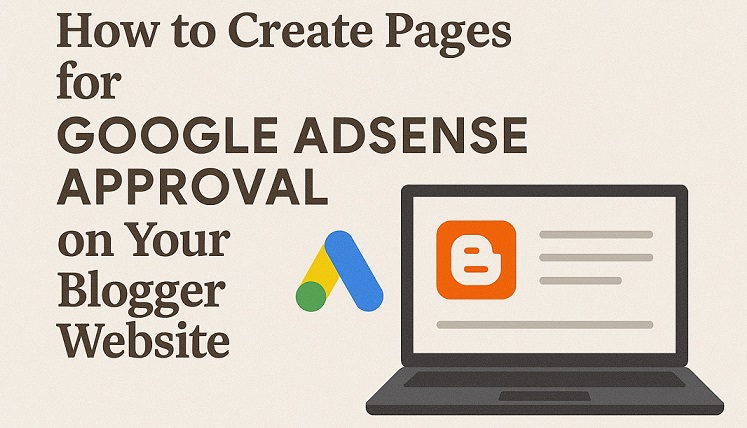How to Update Privacy Policy for Google AdSense: A Complete Guide for Bloggers and Webmasters
Google AdSense Privacy Policy 2025: Update Your Policy for Legal Compliance and Ad Optimization
Privacy Policy for Google AdSense: How to Create and Update It
Key Points for Updating Google AdSense Privacy Policy:
-
Mention of Google's Advertising System:
Add specific information about Google AdSense advertisements:-
"We use Google AdSense, which utilizes cookies and tracking technologies to display personalized ads to users based on their browsing behavior on our website."
-
-
Compliance with New Privacy Policy and GDPR:
If your website is subject to EU or other data privacy laws (such as GDPR), clearly state it:-
"Our privacy policy complies with the GDPR (General Data Protection Regulation), and we are committed to providing users with full control over their data."
-
-
More Information and Opt-out Options:
Provide users with an option to "opt-out of personalized ads." Include a link to Google AdSense’s ad settings to allow users to customize their ad experience:-
"You can manage your ad preferences and opt-out of personalized ads using Google Ad Settings."
-
-
Cookies and Data Collection Information:
Clearly explain what information you collect, such as IP address, location, browser information, etc., and how this data is used for Google AdSense advertisements:-
"We may collect information like your IP address, browser type, and location, which is used for displaying personalized ads by Google AdSense."
-
-
Use of Google Analytics:
If you use Google Analytics, mention how this service tracks traffic and provides data:-
"We use Google Analytics to analyze traffic on our website and improve user experience. Google Analytics may collect data such as your location, device type, and browsing patterns."
-
How to Add the Privacy Policy to Blogger and WordPress:
For Blogger:
-
Go to the Blogger Dashboard:
-
Log in to your Blogger account and go to your Dashboard.
-
-
Create a New Page:
-
In the left-hand panel, click on Pages > New Page.
-
-
Add the Privacy Policy Text:
-
Paste the Privacy Policy text (as per the guidelines above) into the page editor.
-
-
Publish and Add to Menu:
-
Once the page is published, add it to your Footer or Menu so visitors can easily access it.
-
For WordPress:
-
Log in to the WordPress Dashboard:
-
Go to your WordPress admin panel.
-
-
Add a New Page:
-
Click on Pages > Add New.
-
-
Add Privacy Policy Text:
-
Paste the Privacy Policy text (as mentioned earlier) into the editor.
-
-
Publish the Page:
-
Once done, click on Publish to make the page live.
-
-
Add the Page to Your Menu:
-
To make the Privacy Policy easily accessible, go to Appearance > Menus and add the new page to the main navigation or footer.
-
-
For GDPR and Cookies:
-
If you're using WordPress, you can install plugins like Cookie Notice for GDPR or WP GDPR Compliance to manage cookies and ensure compliance with privacy laws.
-
Important Points to Add Regarding Google AdSense Policy:
-
Google Ads Privacy Information:
-
"We use Google AdSense, which tracks your browsing activities and displays personalized ads based on your interests."
-
-
Google Ads Tracking:
-
"Google AdSense and other third-party advertisers may use cookies and other tracking technologies. You can opt-out of personalized ads by using Google Ads Settings."
-
Privacy Policy Template (EduTechAdda Pro Tips)
<!DOCTYPE html>
<html lang="en">
<head>
<meta charset="UTF-8">
<meta name="viewport" content="width=device-width, initial-scale=1.0">
<title>Privacy Policy</title>
<style>
body {
font-family: Arial, sans-serif;
background-color: #f4f7f6;
margin: 0;
padding: 0;
color: #333;
}
.container {
max-width: 1200px;
margin: 0 auto;
padding: 20px;
background-color: #fff;
border-radius: 8px;
box-shadow: 0 2px 10px rgba(0, 0, 0, 0.1);
}
header {
text-align: center;
margin-bottom: 30px;
}
header h1 {
font-size: 2.5rem;
color: #333;
margin: 0;
}
header p {
font-size: 1.2rem;
color: #555;
}
section {
margin-bottom: 30px;
}
section h2 {
font-size: 1.8rem;
color: #1a73e8;
border-bottom: 2px solid #1a73e8;
padding-bottom: 5px;
}
section p {
font-size: 1rem;
line-height: 1.6;
color: #555;
}
footer {
text-align: center;
font-size: 1rem;
padding: 10px;
background-color: #1a73e8;
color: white;
border-radius: 8px;
margin-top: 30px;
}
a {
color: #1a73e8;
text-decoration: none;
}
a:hover {
text-decoration: underline;
}
</style>
</head>
<body>
<div class="container">
<header>
<h1>Privacy Policy</h1>
<p>We value your privacy and are committed to protecting your personal information.</p>
</header>
<section>
<h2>Information Collection and Use</h2>
<p>We may collect the following information:</p>
<ul>
<li>IP Address</li>
<li>Browser Type</li>
<li>Pages Viewed</li>
</ul>
<p>This information is used to improve the quality of our website and enhance the user experience.</p>
</section>
<section>
<h2>Cookies</h2>
<p>We and our third-party partners (such as Google AdSense) use cookies to display personalized ads based on your interests. You can control or disable cookies through your browser settings.</p>
</section>
<section>
<h2>Third-Party Advertisers</h2>
<p>Advertisements displayed on our site may be served by third-party advertisers, who may collect your information. We are not responsible for the privacy practices of these third parties.</p>
</section>
<section>
<h2>Your Rights</h2>
<p>You have the right to access, modify, or delete your personal information. If you wish to exercise any of these rights, please contact us using the information provided below.</p>
</section>
<section>
<h2>Contact Us</h2>
<p>If you have any questions regarding our privacy policy, feel free to contact us:</p>
<p>Email: <a href="mailto:your-email@example.com">your-email@example.com</a></p>
</section>
<footer>
<p>© 2025 Your Website Name. All rights reserved.</p>
</footer>
</div>
</body>
</html>
How to Add the Privacy Policy to Your Blog:
For Blogger:
-
Follow the steps above to create a new page and paste the HTML code.
For WordPress:
-
Follow the steps outlined earlier for WordPress, and paste this HTML code into the page editor.
Frequently Asked Questions (FAQ)
-
Why do I need a privacy policy on my website?
-
A privacy policy is essential because it informs users about the data you collect, how you use it, and how you protect it. If you're using Google AdSense, a privacy policy is required. It also helps comply with privacy laws like GDPR and CCPA.
-
-
What information does your website collect?
-
We collect both personal and non-personal information. Personal information includes data you provide voluntarily, like your name or email address. Non-personal information includes your IP address, browser type, and page visits, which help us improve user experience.
-
-
How does Google AdSense use my data?
-
Google AdSense uses cookies and tracking technologies to display personalized ads based on your browsing history and interests. You can opt out of personalized ads by visiting Google Ads Settings.
-
-
What are cookies, and why are they used?
-
Cookies are small text files stored on your device when you visit a website. They help websites remember your preferences, improve user experience, and serve personalized ads. We use cookies to track interactions with our site and display relevant ads.
-
-
Can I control or delete the cookies used on your site?
-
Yes, you can manage your cookie preferences by adjusting your browser settings. You can also opt out of personalized ads through Google Ads Settings.
-
-
Do you share my data with third parties?
-
We use third-party services like Google AdSense and Google Analytics to improve your experience on our website. These services may collect and process data. We are not responsible for their privacy practices.
-
-
How can I opt-out of personalized ads?
-
You can opt-out of personalized ads by visiting Google Ads Settings. You can also manage cookie preferences through your browser settings.
-
-
How long do you retain my data?
-
We retain personal data only as long as necessary to provide our services. Non-personal data may be retained longer for website analysis. You can request data deletion at any time by contacting us.
-
-
Can I request my data?
-
Yes, you have the right to access, modify, or delete your personal data. Please contact us at [your-email@example.com] to exercise these rights.
-
-
How do I contact you about my privacy concerns?
-
If you have any questions or concerns about our privacy policy, feel free to contact us via email at [your-email@example.com].














Post Your Comment